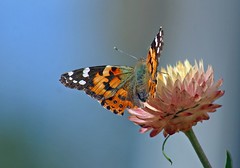
When creating a butterfly garden, the possibilities of what to include in your butterfly garden designs are endless. Below are some suggestions to help get you started when designing your butterfly garden plan. They are designed to spark the creative process of your mind and get you started on your way to creating a lovely and well-suited butterfly garden.
- First, before you even begin your butterfly garden, find out which species of butterflies are in your area. Consider taking an exploratory hike around your location with a butterfly identification book to find the butterflies that dwell close to your property. This may take a little extra time and some research on your part but the results will be worth the effort. After you have compiled your list of local butterfly species, be sure to write down in your butterfly garden plan what these particular species of butterflies use for nectar and food plants.
- Be sure that your butterfly garden plan includes a location that provides at least six hours of sunlight per day. Butterflies are cold-blooded creatures and therefore, do better where they are warm and sheltered.
- Wind can be a butterfly’s worst enemy so be sure to have plenty of wind protection in your butterfly garden design. You can plant tall shrubs and other plants in order to create a wind break. Know the direction of your area’s prevailing winds. The first choice, however, is a nice ‘tucked away’ location that avoids heavy winds.
- Keeping the above points in mind, choose a suitable location to have your butterfly garden. The best of all worlds would be a butterfly garden placed on the south side of your home with windbreaks on both the west and east sides. You may also wish to be sure that you are able to view you butterfly garden from inside your home as well as provide seating outside from which to observe the antics of the butterflies.
- If your area permits, a possible suggestion for location of a butterfly garden is provided by Barbara Damrosch in her book Theme Gardens. She suggests the use of an old basement or home foundation if such is available around your home or the place you wish to have your butterfly garden. As an alternative, you can excavate an area and build a stone wall around the excavation to simulate an old construction foundation. Remember to covered the bottom of the excavation with several inches of gravel where you do not intend to plant your nectar and food plants for the butterflies. This will save you from a muddy walk through your butterfly garden after a rain.
There are many creative ways for constructing a butterfly garden. Take your time to design a garden that you will enjoy and be proud of later when all is said and done.
Source: http://www.backyardgardeningtips.com/backyard-garden/planning-your-butterfly-garden/




